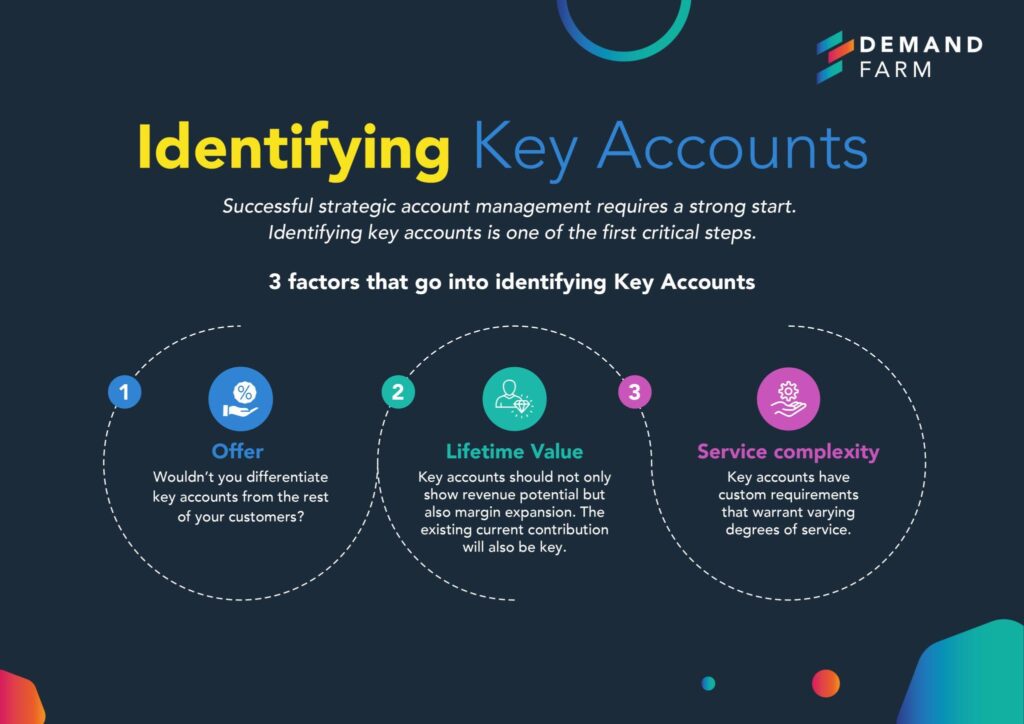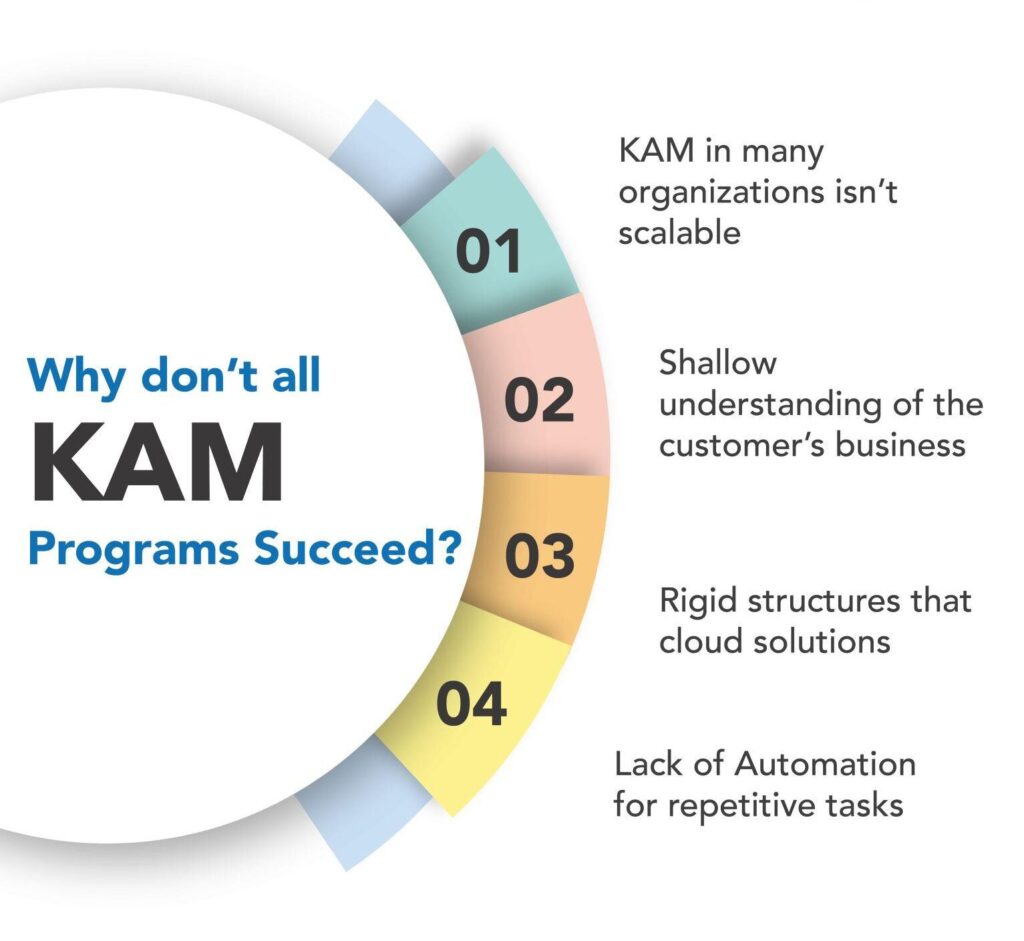Key Account Management Plan
As the saying goes, ‘failing to plan is planning to fail’. This could not be more true when it comes to Key Account Management. Creating and maintaining a Key Account Management plan can be critical to the success of your business. After all, your key accounts are the customers that bring the most revenue and profit. So it only makes sense to invest the time and resources necessary to keep them happy. But what goes into a Key Account Management plan?
A Key Account Management plan will help you map out your approach, stay organized, and on track as you work to grow and nurture your relationships with your key accounts. If you are not sure where to start, don’t worry. We’ve got you covered with this Key Account Management plan template. We provide a systematic approach to analyze your customers, identify key areas, and adopt best practices of Key Account Management planning.
6 Steps of Key Account Management plan
Broadly, a Key Account Management plan can be divided into 6 categories or steps: account analysis, self-analysis, business development, action plan, monitoring, and reviewing the plan. Each of these sections will provide you with an opportunity to capture information that you need to improve your business and ensure customer satisfaction.
Step 1: Account analysis
When creating a Key Account Management plan, start by analyzing your current accounts. This will give you a better idea of how to focus your marketing efforts. Also, it will help you identify the pockets of potential growth. For example, do you have any new customers on whom you are not able to collect data? Are there existing customers who are not satisfied with their experience? These and other questions can help you identify areas where you need to improve.
Get to know their business better – what are their goals, what are their challenges, what are their priorities? Here’s a list of questions to guide you through some research:
- What is their company culture like?
- How do they view themselves?
- What is their budget like?
- How many employees have they hired?
- For each employee, what is their role description?
- What are their key performance indicators?
- What are the challenges the key account is facing?
Best practice: You may find it helpful to create a diagram or table that illustrates the relationships between these various parts of your key account. Invest in an automated solution that can improve the integrity of your data while enhancing the research process.

Step 2: Self-analysis
What analytics can help you to understand is what type of information you need to focus on in order to improve your business. This includes customer requirements, competitive analysis, product development, and technical excellence. Depending on the situation, one or a combination of these elements will need to be emphasized.
Current customers can be analyzed using a number of tools. You can use analytics and automation to get a handle on how your customers interact with your business. This will help you identify customer pain points that you can address with changes to your product or service. You can also analyze performance data to identify how your products perform. This can include identifying customer complaints, feedback, and satisfaction issues. Lastly, you can analyze sales projections to determine how much revenue you will be making in the coming year.
These projections are based on estimated sales growth, which uses data from your previous experiences with similar products and services. All this information will help you create a list of initiatives that you need to address in your key account management plan. Define your objectives by answering questions like: What is your key account trying to achieve? What’s the bigger picture? Differentiate yourself by linking your capabilities to their key objectives.
Best practice: Clearly define your objectives and allocate specific business units to a generic team rather than a specific account manager – it will foster a creative, collaborative culture.
Step 3: Business development
In order to sustain growth, businesses must constantly look for ways to improve their offering. This can include new products, processes, and services. However, innovation is not just for startups. Even large companies must continually look for ways to improve performance. For example, how can a company increase sales by 10% without increasing prices? How can they do this by improving their service? Or by adding new products that are both cost-effective and attractive to customers?
Analyze the current state of the account and the factors that affect it. Consider this
- Market position (leadership, growth potential, share of market, price sensitivity)
- Business unit performance (income, cost, margin, growth potential)
- Current contracts (length, renewal likelihood, value, special terms and conditions)
- Customer service/relationship quality ratings (impact on new business opportunities)
- Competitors’ status (what are they doing?)
- Potential business opportunity value (current and future)
- Critical success factors (what would make the account happy?)
- Optional technology benefits
Knowing this will help you frame how you approach the project. Also, it will help you identify the type of research needed to understand the client’s industry better.
Best practice: Depending on the type of research you are doing, you can either outsource it to a specialist, or hire a professional researcher to do it for you. If you are conducting consumer research , you can create a survey or you can ask people who are familiar with the company to complete questionnaires for you.
Step 4: Action plan
Once you’ve done the research and analysis, it’s time to create your plan. Don’t worry about being perfect at this point – just get your plan drafted and then review it with your key account manager. Ensure everyone is committing to achieving the goals. A successful Key Account Management plan will show you where you need to go next to grow your business and build more value for your customer.
Define timelines that are achievable and align with your objectives.
- What’s the short-term goal?
- What is the best time to do it?
- How will you achieve your goal?
- Who is responsible for each task?
Focus on high-leverage activities to understand what takes up your time. What is unlikely to generate new business? Eliminate or reduce these tasks to make way for more productive activities. Focus on activities such as one-on-one meetings, phone calls, writing, project reviews, and research.
Best practice: Don’t overload yourself or your team at first – ease into your plan gradually. This will help you get used to the process and avoid procrastination. Focus on one task at a time to ensure consistency and improve your performance. Celebrate your victories (big or small) to keep yourself motivated.
Step 5: Track and monitor your progress
Once your Key Account Management plan is underway, you need to make sure you’re tracking and monitoring your progress. Did you commit to too much? Are you going to get done on time? Ensure that you take some time to review your progress so that you can course-correct if necessary.
In addition, review your customer’s performance. Did they meet their commitments to you? If not, why not? This will give you insight into what they are seeing or feeling so you can position yourself for future advantage.
Set up a progress report template to ensure that you are able to capture all the data and information that you need to compile a report on your key account management efforts. A template will ensure that you do not miss any important information and that you can easily compare your progress between different reports.
Best practice: Set up a Key Account Management software to manage and organize all your key accounts and objectives. You can set up a project for each of your key accounts, or you can create a general project for all of your client work. Using software will ensure that you don’t lose track of any elements of your work and can easily revisit past projects or templates to ensure consistency between projects.
Step 6: Revise and improve
No plan is ever set in stone. Your Key Account Management plan isn’t any different. Don’t be afraid to review and revise your plan. Keep records of your Key Account Management activities to ensure you can recognize your successes and learn from your failures. Review your activity logs at the end of each month to evaluate your performance and effectiveness.
Keep a PMO (project management office) or project management software can help you manage and organize all of your
- Does the plan reflect the results of your analysis?
- Are the goals realistic and achievable within the timelines?
- Are there any parts of the plan that need to be revised or updated?
Best Practice: Review your plan on a quarterly basis at the very least.
How to overcome challenges while creating a KAM plan template?
Although a Key Account Management plan can provide tremendous benefits to both you and your customer, the process of developing and executing such a plan is not without challenges. Challenges such as time, resources, information and organizational culture can impede your team’s ability to succeed with the plan.
Masterclass by Forrester Principal Analyst – Why companies fail with key account management?

- Time constraints: Time is a precious resource, and your customer may not have much of it to invest in you or your organization. You need to ensure that you don’t put unnecessary pressure or demands on them that they can’t meet. Similarly, you don’t want to delay delivering on your promises because you’re waiting on a customer to meet you halfway. Be creative and resourceful in meeting both of your obligations.
- Resource constraints: Your team may not have the resources (human or technical) necessary to complete Key Account Management activities. Ensure that you thoroughly review the requirements and focus on those that provide the most value. Then prioritize the requirements and take time to prepare yourself and your team to tackle Key Account Management plan requirements from both a quality and time perspective.
- Incompatible organizational culture: Although most organizations attempt to integrate their culture with that of their customers, in some instances the two are fundamentally incompatible. If this is the case in your scenario, then it is likely that you will not be able to change your customer’s culture. Instead, you will need to carefully strategize how you will adapt yourself and your operations to accommodate your customer culture.
- Differing priorities: Your customer may have conflicting priorities which prevents them from fully engaging with you. For example, they may have a new product launch they are prioritizing above all else. This may mean that they are unavailable to participate in any collaborative events you plan with them or their other key accounts. Ensure that you have a backup plan that allows you to engage with them in some way to ensure retention of the relationship.
- Uncertainty surrounding Key Account Management plan effectiveness: The results your organization achieves when performing key account management activities are often uncertain until some time has passed. Ensure people from all departments are prepared for this and ensure leaders are able to course correct if required.
- Cost-effectiveness of activities: It is possible that the time or costs associated with an activity designed to nurture your customer could result in a negative return on investment (ROI). Ensure you’re not unnecessarily draining your resources. Eliminate or reduce the impact of activities that are not worth the cost or time required to deliver them.
- Lack of or ineffective tools and systems: There are many technology solutions available to help you manage your key accounts more effectively. A common complaint we heard was that the tools and systems provided by the company were underdeveloped or clunky, so much so that they frequently caused more headaches than they alleviated. Ensure that the tools and systems you require to manage your key accounts are state-of-the-art and functional.
As you can see, there are many different elements that go into a successful key account management plan. Success with your key account management plan will require commitment and discipline from you and your team. Prepare yourself and your team before you launch the plan. Ensure everyone is clear on their responsibilities and timelines. Use resources such as one-on-one meetings, group meetings, phone calls, or a virtual meeting platform to engage your team and address any concerns early on.
By taking the time to put together a detailed and well-thought-out plan, you can increase your chances of success and make it easier to manage your key accounts. Use this template to keep your key account management plan organized and ensure that you are providing the best possible service to your most important clients.

